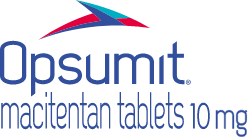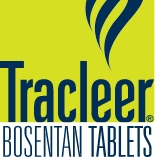See clinical trial results for patients who received continuous intravenous (IV) epoprostenol plus conventional therapy*
*Compared to those who received conventional therapy alone.
By clicking “CONTINUE” below, you will be taken to a website that may contain links or references to other websites to which our Privacy Policy may not apply. We encourage you to read the Privacy Policy of every website you visit.
You are solely responsible for your interactions with such websites.
The information contained in this section of the site is intended for US healthcare professionals only.
Click the appropriate link below.
Please see full Prescribing Information, including BOXED WARNING for OPSUMIT®.

Please see full Prescribing Information, including BOXED WARNING for TRACLEER®.

Please see full Prescribing Information for VENTAVIS®.

Please see full Prescribing Information for UPTRAVI®.
Clicking CONTINUE below will take you to the selected site, the content for which Janssen is not responsible and to which this Privacy Policy does not apply. We encourage you to read the Privacy Policy of every online service you visit.
CONTINUE*Compared to those who received conventional therapy alone.
Epoprostenol was studied in 2 prospective, open-label, randomized trials of 8 and 12 weeks duration (pooled data results) in patients with idiopathic pulmonary arterial hypertension (IPAH) or heritable PAH (HPAH). Patients were New York Heart Association (NYHA) Functional Class III or IV, except for 2 patients who were NYHA Functional Class II.
Epoprostenol plus conventional therapy
(n=52)†
Conventional therapy alone
(n=54)†
Dosage of epoprostenol was determined as described under dosage and administration and averaged 9.2 ng/kg/min at study's end. In the 12-week, open-label, randomized, parallel study:
| • | The primary endpoint was a change from baseline in exercise capacity as measured by the 6-Minute Walk Test |
| • | Other major study objectives included the effect of epoprostenol on survival and quality of life (using the Chronic Heart Failure Questionnaire, the Nottingham Health Profile, and the Dyspnea-Fatigue Rating) |
| • | The authors also evaluated the effects of epoprostenol on hemodynamics1 |

Statistically significant improvement was observed in exercise capacity, as measured by the 6-Minute Walk Test
Improvements were apparent as early as the first week of therapy



Increases in exercise capacity were accompanied by statistically significant improvement in dyspnea and fatigue.‡

None of the 41 patients receiving epoprostenol died.
8 of 40 (20%) patients receiving conventional therapy alone died (P=0.003).
At the end of the treatment (12 weeks)2:
No statistical difference in survival was observed in patients with PAH associated with scleroderma spectrum of diseases (PAH-SSD).
| Baseline Values | Mean Change From Baseline at End of Treatment Period§ | |||
|---|---|---|---|---|
| Parameter | Epoprostenol Plus Conventional Therapy (n=52) | Conventional Therapy Alone (n=54) | Epoprostenol Plus Conventional Therapy (n=48) | Conventional Therapy Alone (n=41) |
| CI (L/min/m2) | 2.0 | 2.0 | 0.3|| | -0.1 |
| mPAP (mmHg) | 60 | 60 | -5|| | 1 |
| PVR (Wood units) | 16 | 17 | -4|| | 1 |
| mSAP (mmHg) | 89 | 91 | -4 | -3 |
| SV (mL/beat) | 44 | 43 | 6|| | -1 |
| TPR (Wood units) | 20 | 21 | -5|| | 1 |
| Baseline Values | |
|---|---|
| CI (L/min/m2) | |
| Epoprostenol Plus Conventional Therapy (n=52) | 2.0 |
| Conventional Therapy Alone (n=54) | 2.0 |
| mPAP (mmHg) | |
| Epoprostenol Plus Conventional Therapy (n=52) | 60 |
| Conventional Therapy Alone (n=54) | 60 |
| PVR (Wood units) | |
| Epoprostenol Plus Conventional Therapy (n=52) | 16 |
| Conventional Therapy Alone (n=54) | 17 |
| mSAP (mmHg) | |
| Epoprostenol Plus Conventional Therapy (n=52) | 89 |
| Conventional Therapy Alone (n=54) | 91 |
| SV (mL/beat) | |
| Epoprostenol Plus Conventional Therapy (n=52) | 44 |
| Conventional Therapy Alone (n=54) | 43 |
| TPR (Wood units) | |
| Epoprostenol Plus Conventional Therapy (n=52) | 20 |
| Conventional Therapy Alone (n=54) | 21 |
| Mean Change From Baseline at End of Treatment Period§ | |
|---|---|
| CI (L/min/m2) | |
| Epoprostenol Plus Conventional Therapy (n=48) | 0.3|| |
| Conventional Therapy Alone (n=41) | -0.1 |
| mPAP (mmHg) | |
| Epoprostenol Plus Conventional Therapy (n=48) | -5|| |
| Conventional Therapy Alone (n=41) | 1 |
| PVR (Wood units) | |
| Epoprostenol Plus Conventional Therapy (n=48) | -4|| |
| Conventional Therapy Alone (n=41) | 1 |
| mSAP (mmHg) | |
| Epoprostenol Plus Conventional Therapy (n=48) | -4 |
| Conventional Therapy Alone (n=41) | -3 |
| SV (mL/beat) | |
| Epoprostenol Plus Conventional Therapy (n=48) | 6|| |
| Conventional Therapy Alone (n=41) | -1 |
| TPR (Wood units) | |
| Epoprostenol Plus Conventional Therapy (n=48) | -5|| |
| Conventional Therapy Alone (n=41) | 1 |
| • | Cardiac Index by 15% |
| • | Stroke Volume by 14% |
| • | Mean Pulmonary Arterial Pressure by 8% |
| • | Pulmonary Vascular Resistance by 25% |
| • | Total Pulmonary Resistance by 25% |
There was significant improvement in hemodynamics for patients who received chronic continuous infusions of epoprostenol plus conventional therapy compared to patients who received conventional therapy alone.
The most common and dose-limiting adverse events during dose initiation and escalation (≥1%) were:
| • | Flushing (58%) |
| • | Headache (49%) |
| • | Nausea/vomiting (32%) |
| • | Hypotension (16%) |
| • | Anxiety/nervousness/agitation (11%) |
| • | Chest pain (11%) |
| • | Dizziness (8%) |
| • | Bradycardia (5%) |
| • | Abdominal pain (5%) |
| • | Musculoskeletal pain (3%) |
| • | Dyspnea (2%) |
| • | Back pain (2%) |
| • | Sweating, dyspepsia, hypesthesia/paresthesia, tachycardia (1%), respectively |
Adverse events occurring in patients with idiopathic or heritable PAH with ≥10% difference between epoprostenol and conventional therapy alone were:
| • | Chills/fever/sepsis/flu-like symptoms (25% vs 11%) |
| • | Tachycardia (35% vs 24%) |
| • | Flushing (42% vs 2%) |
| • | Diarrhea (37% vs 6%) |
| • | Nausea/vomiting (67% vs 48%) |
| • | Jaw pain (54% vs 0%) |
| • | Myalgia (44% vs 31%) |
| • | Nonspecific musculoskeletal pain (35% vs 15%) |
| • | Anxiety/nervousness/tremor (21% vs 9%) |
| • | Dizziness (83% vs 70%) |
| • | Headache (83% vs 33%) |
| • | Hypesthesia/hyperesthesia/paresthesia (12% vs 2%) |
Thrombocytopenia has been reported during uncontrolled clinical trials in patients receiving epoprostenol.
Potential adverse events from postmarketing evaluations include anemia, hypersplenism, pancytopenia, splenomegaly, and hyperthyroidism.
Although the relationship to epoprostenol administration has not been established, pulmonary embolism has been reported in several patients taking epoprostenol and there have been reports of hepatic failure.
References: 1. VELETRI® (epoprostenol) for Injection Full Prescribing Information. Actelion Pharmaceuticals US, Inc. 2. Barst RJ, Rubin LJ, Long WA, et al. A comparison of continuous intravenous epoprostenol (prostacyclin) with conventional therapy for primary pulmonary hypertension. N Engl J Med. 1996;334:296-301.